11 Tips For First Time Boaters
This is a little off-topic for my blog but we recently came back from a week’s holiday on a beautiful Broom’s Boats, boat courtesy of Hoseasons. Since there were a number of things that I really wish I had known before going, I am going to describe some of my experiences whilst sailing in the lovely Norfolk rivers and hopefully help others have an even nicer break away.
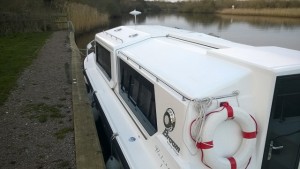
Steering
This is the most obvious one and it is worth mentioning a few things about how to steer the boat. Fortunately, we had someone show us that was incredibly patient and thorough, but this is still something that will take a little time to get comfortable with. The main thing to understand is that when you turn the wheel, the boat will not respond immediately. This is something I needed to over-learn again and again :-) The trick is to make small movements and then wait. Let me say that again…wait…because it can take a few seconds for the boat to react to what you are doing. If you don’t, you will start weaving left and right in some drunk-like fashion which must be quite entertaining for onlookers! One tip I found worked for me was to focus on some distant object like the bend of the river, or some far off tree, and try to keep that object located at that position relative to something on the boat. In our case, I had a spot between some hanging rope and the very tip of the boat’s railings just outside the window, which I used to line things up. If you do that, I found, you seem to go in much more of a straight line. As for position, it is probably best to remain in the middle of the river when you can. You will need to watch for the other boats, but at least here you have some room to drift. If you do go near the banks, pay close attention to the depth gauge and any trees/reeds - some of the come out quite far and can pop up from nowhere. The last thing I quickly realised is that unlike driving a vehicle, you can’t let your concentration lapse for even a second. There are so many variables that control where the boat goes that if you take your mind off navigating it, you can find yourself veering off to the sides of the banks or worse yet, towards other boats. Therefore, if you are the only one captaining the boat, you can expect to be sitting in that chair glued to the wheel (and focussing) for a very long time. Bear this in mind if you are likely to be the only one driving; it basically means that your holiday will be a tale of two holidays - the one your family will have, and yours!
Mooring
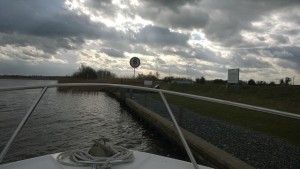
Oh my! This can be stressful! The key to getting this to work is teamwork because you really need someone who will jump off and tie the boat to the side for you. Without that, it is impossible to lesser or greater degrees depending on the way the water is moving. Hold on…can things be worse or better than impossible!? Here are my tips though:
- Pull in at an angle of about 30 degrees, slowly.
- Make sure you are moving towards the direction of the tide. This can be tricky to fathom so if need be, slow down beforehand to know which way the water is travelling. Be prepared to turn the boat around and come in from the other direction if necessary.
- Have all your ropes (front and back) ready to be used – I made the mistake of tying them up around a rail one time which made Mrs Logical quite angry when we began mooring :-)
- Make sure you attach the boat to the mooring points, starting at the back. Now, this might not be the proper way to do things (and you should definitely experiment or listen to people more knowledgeable) but I found the part that gave me the most trouble was the back of the boat. That’s the bit that is harder to control and can swing out, so get that tethered down first.
- Only put two knotted rings (or so) around the mooring point before going to the other end and attaching that; you can always add more once the boat is stable.
- Leave some slack in the ropes. We left about a foot (30 cm) of rope which passed over the edge where the water is, towards the boat. The reason for this is so that if the water drops (it does!), you don’t end up forcing the boat to tilt.
- Look out for the free mooring points. You can just see the sign to watch for in my image above but see my section on reading signs, below, too.
The Dreaded Toilet
Our toilet cum bathroom was only slightly larger than standing room. Whilst being really well designed, this made using the toilet (especially if travelling) really difficult. You can see from my picture above how big our boat was but this compartment is only a small fraction of that. I am 6ft 1” and pretty broad. If you are bigger than that, consider this before choosing which boat you want to hire; I really struggled in there. Another issue is the tank that lies within the boat which is used to contain all of the things that get flushed down the loo. Our toilet was quite interesting in that there was a dial besides it which indicated how full the tank was. Sadly, that pointer would suddenly move quickly up! I wish I had taken a picture because I can’t remember what each of the segments were labelled as, but I am sure that it went into the red zone far too quickly. That might change if you flushed just water down; presumably it meant that it moved a blockage away from the sensor? As it turned out, our family of 4 (2 adults & 2 logicals) did fill it up by the end of the 4 day break, but we managed that by being very economical with flushing (yes, yuck!) and not using too much tissue. You can imagine how much we laughed when we dropped the boat off and found out that we could have it emptied at any time for free at Broom! Do check this with your hire company because to get the tank emptied anywhere else will cost you about £18. Lastly, don’t forget about the many pubs - you can use those if you buy something.
Communication
When you are driving and you want to communicate with people outside the main cabin, this can be tricky. Why would you want to do that? Well, one reason is when mooring up so that you can say things like: “I’m going to pull away and try again.“ or, “Have you attached the back yet?“. Equally, the people outside could be telling you about clearances at bridges or whether you are getting to close to the banks. We used our daughter as a conduit meaning she stood at the doorway and relayed messages but it would have been SO much easier if we had some walky talkies that could be clipped onto a lapel. Next time…
Bridges
The height of your boat and the height of the water are crucial things to be aware of when going under bridges. Luckily for us, we didn’t need to pass under any that needed raising, partly because of the design of the boat but also because we hoped to avoid them. So, for those situations, I can’t comment. Instead, let’s discuss the ones where you will hopefully glide underneath. One thing to watch out for is that you don’t have any parts sticking up. In our case, it was the TV aerial, so be careful that you lower that. Also, pay close attention to the bridge markers located on the approaches. Here’s an example:
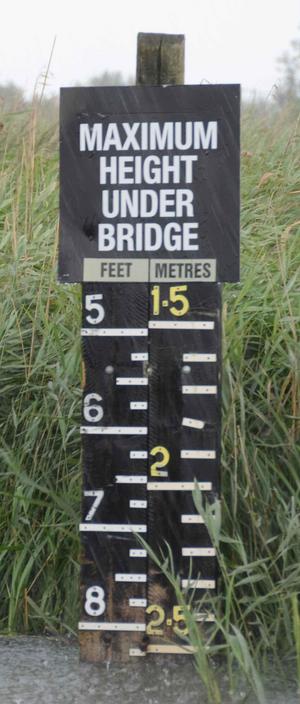
Simply take the height of the boat (you should have been told this - ours was about 6ft) and make sure that the number at the bottom is at least that much. If in doubt, you can always wait till the tide drops, the bridge is opened (if it can) or just turn around! Going through the bridge can be a little shaky so have someone out front relaying how you are doing, pay close attention to your position (aim for the middle) and then if all is looking good, get under and away as quick as you can. Lastly, if you think another boat is approaching, just let them go first; why create drama!?
Routes
We picked our boat up at Brundell and then travelled towards Beccles (avoiding Great Yarmouth) and then back towards Brundell before heading onwards to Norwich. Of that, we definitely preferred the Norwich direction because it is just so much prettier. The other route is largely industrial or just fields with reeds along the sides. Of the two, the Norwich side is also much shorter (from Brundell), though, so despite what I have written above, you will probably go both ways. The reason we avoided Great Yarmouth was because there were bridges (or locks?) that would have been trickier to navigate and we didn’t need any undue stress. Be aware that there are very few places that are picturesque enough to warrant much of a stop other than for somewhere to sleep towards Beccles. Beccles has a town and I think Reedham does too (though we didn’t stop there) but not much else. There was one other place which looked nice (sorry, I can’t remember the name, but you will recognise it when you see the boats moored up) but that seemed more like a tourist destination. Towards Norwich, other than at Brundell, there are some nice places to stop, but again, not much in the way of shops until you get to Norwich.
Food
I’ve already spoken a little about how there were few shops where we were, so before you go, have at least one days worth of food for your party. Also, think about packaging; we had a terrible time finding bins so kept most of the rubbish on board, which soon piled up. Needless to say, things which are easy to cook/heat are preferable. It’s also a good idea to look for items that have multiple uses such as bread - that can be used for sandwiches, toast in the morning or for snacks like cheese on toast. One other option is to moor up where there are pubs. We saw some on our route but never went into any. Some looked really nice, though. It was also hard to know whether they were open but to be fair, we went at the end of March, so it wasn’t exactly peak season.
Water
There were quite a few places you could fill up along the way, so you can usually find a way to replenish this. In our case, we used about half of the tank but we were very frugal about water usage, especially when it came to showers. That is in stark contrast to what we are like at home, so it took a little adjustment and some creativity. For example, we would have a quick blast of the shower to get wet, then turn it off. Then wash. Then one quick blast again. I am sure if we all did this at home, we would never have water shortages! You ought not to drink the on-board water, so bring your own.
Reading Signs

My son had the good sense to bring some binoculars. Sadly, he brought a toy pair and doubly shamefully, his dad didn’t even have the sense to do that! They are invaluable when trying to read signs as you travel past, check out those clearance markers above, or just to watch the wildlife.
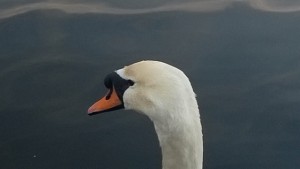
In short, they are essential, so don’t forget them.
Electricity
This wasn’t really a problem for us but that is based on the following:
- We probably ran the motor (which charges the batteries) for about 4 hours a day as we travelled at a gentle pace up and down the river.
- At night, we only really watched a couple of hours of TV.
- We used the cooker for lunch and dinner, each day.
- We also ran the heaters quite a lot; it was cold at night in that part of England.
There are places you can charge the batteries, but we never needed to.
Reeds
I’ve had to leave this section till the end because it is by far the most painful ;-) These things are everywhere and you will almost certainly worry about them for three reasons:
- If your propeller gets caught in them, it can obstruct it, preventing you from moving.
- You can get wedged in there and unable to free yourself.
- You are necessarily close to the edge of the bank where the depth isn’t that much, risking damaging the hull of the boat.
We probably went too near the reeds about a dozen times, and actually went into them twice, one of which is the story I will tell you below. Our biggest cause of stress (and I know I haven’t said this yet, but trust me, driving a boat is very stressful!) was at a bridge we came to near Reedham, I think.
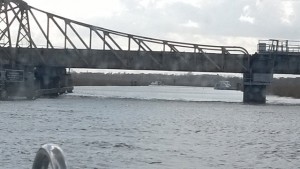
Another boat was in front of us which then got into trouble near the reeds, so we held back. They managed to free themselves by which point we had moved further up the river, just in front of them. We then got caught in the current and were pushed into exactly the same position they were, alongside the bank, just in front of the bridge. In the image above, it would be to the left, just beyond the edge of the shot. As I’ve already said, reeds=bad, so we tried to reverse, but the water just pushed us closer to the edge. On top of that, we were dangerously close to this big stake sticking out of the water, so that reduced our space further. Each attempt to move out just seemed to put us deeper into the mire because the current was so strong and we were hampered by the reeds. Next, we tried to use the pole on-board to try to push us out, but that wasn’t very strong and didn’t help much. The people we had passed were now a bit further back, sitting on their deck at the stern of the boat, enjoying a cigar, and watching this spectacle! I just sat still and waited. This was my attempt at a calming move so that Mrs Logical didn’t panic, but honestly, I thought we were done for! By this time, we had probably been stuck for about 10 or 15 minutes, but it felt like much more. I decided to make one more push for it. I reversed hard and at the same time, put the side thruster on (this is a jet of water, I guess, that streams out from the front left or right, pushing you). We edged back. I reversed harder, and that seemed to help, but the front was still firmly stuck against the reeds, and the back was being pushed again, towards the edge. I then went for it, switched the throttle to push us forwards, pressed the side thruster on full, turned the wheel to full lock-right and just hoped for the best. It was difficult because we were working against the current, but inch by inch, I could see the boat begin to swing right. This spinning got faster until the front was clear of the stake and just beyond perpendicular to the river. I then straightened the wheel and slammed forwards, clearing the bank. What I didn’t know is that Mrs Logical watched the back of the boat swing hurriedly across the water, missing the stake by about 3cm! I’m glad because I was already sweating what I did know. Hopefully that gives you a small idea of what it can be like to get caught. Reading this back, I don’t think I have quite captured my sense of panic and fear at this situation, but trust me when I say I was incredibly relieved afterwards!
Conclusion
Have I put you off boating? I hope not. In some senses it is a lot of fun but knowing the above will make you forewarned and hopefully give you a truer sense of what to expect, enhancing your experience.
Hi! Did you find this useful or interesting? I have an email list coming soon, but in the meantime, if you ready anything you fancy chatting about, I would love to hear from you. You can contact me here or at stephen ‘at’ logicalmoon.com